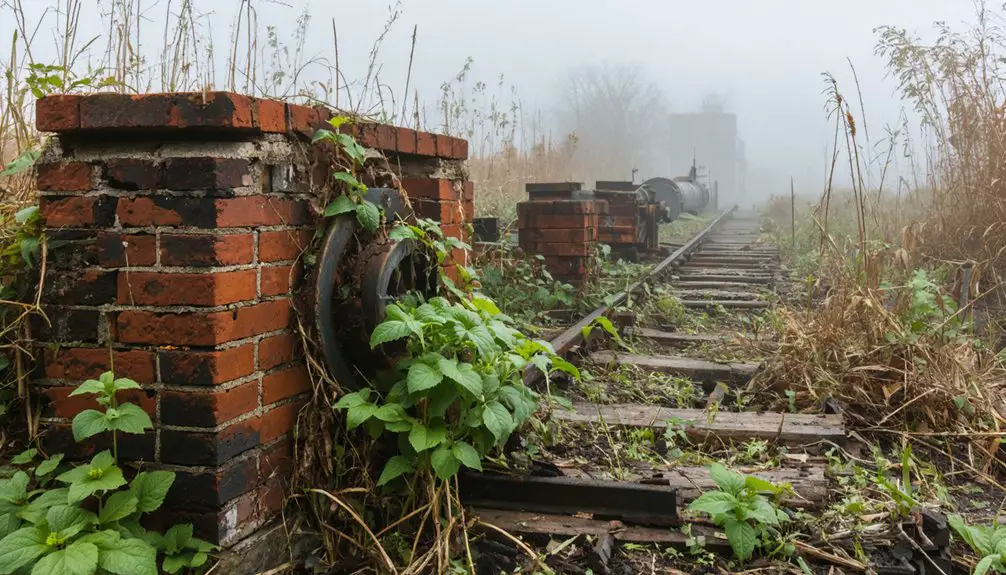You’ll discover Mentha as a ghost town in Pine Grove Township, Michigan, where A.M. Todd once built a mint empire controlling 90% of the world’s mint oil production by the early 1900s. The town thrived along the Kalamazoo & South Haven Railroad, specializing in Black Mitcham peppermint cultivation across 1,850 acres. After devastating crop diseases in the 1970s and the railroad’s closure, Mentha’s bustling community vanished, leaving scattered ruins that tell an intriguing story of agricultural innovation.
Key Takeaways
- Mentha, Michigan was a prosperous agricultural town that controlled 90% of the world’s mint oil production by the early 1900s.
- The town’s decline began with railroad closures, particularly when Penn Central Railroad ceased operations in 1971, isolating the community.
- A devastating verticillium wilt outbreak in the 1970s destroyed peppermint crops, effectively ending commercial mint cultivation in the area.
- The loss of mint farming and railroad access led to mass exodus, transforming Mentha from a thriving community into a ghost town.
- Few original structures remain today, with only scattered houses and a reportedly haunted hotel as remnants of the once-bustling mint town.
The Rise of Michigan’s Mint Empire
While many American ghost towns emerged from mining booms, Mentha’s rise to prominence stemmed from an unlikely source: mint.
Located in Van Buren County, just northwest of Kalamazoo, Mentha transformed into a global powerhouse of mint flavoring innovations under A.M. Todd’s visionary leadership.
Under A.M. Todd’s guidance, a small Michigan town became an unexpected epicenter of global mint production and innovation.
You’ll find the roots of this empire in the late 19th century, when the Kalamazoo & South Haven Railroad connected the region to lucrative markets through Great Lakes ports.
The historical market dynamics were staggering – by the early 1900s, you’d see Mentha controlling 90% of the world’s mint oil production. This high-quality mint oil was potent enough that one single pound could flavor 135,000 sticks of chewing gum.
The A.M. Todd Company’s 1,850-acre operation mastered both peppermint and spearmint cultivation, producing essential oils for everything from medicines to chewing gum, while revolutionizing farming techniques and hybrid development. Unfortunately, the thriving industry faced a devastating setback when verticillium wilt disease devastated the local peppermint crops.
A.M. Todd’s Vision and Agricultural Legacy
At the heart of Mentha’s rise stood A.M. Todd, a visionary who transformed Michigan’s mint industry through relentless innovation strategies.
You’ll find his impact most evident in his revolutionary approach to mint cultivation, where he patented mechanical root planters by 1907 and pioneered advanced extraction techniques that set new industry standards. His introduction of Black Mitcham peppermint from England revolutionized American mint farming, becoming the dominant variety by 1900.
Todd’s research-driven mindset didn’t stop at peppermint. He expanded into diverse botanical extracts, from chili to hops, while developing sophisticated plant-breeding programs. By 1928, his company had achieved market dominance in the essential oil industry.
You can trace his influence through the establishment of the Michigan Peppermint Growers Association and his company’s groundbreaking use of gas-liquid chromatography for spice extraction.
His legacy lives on in the agricultural practices that helped Michigan compete globally, despite regional challenges, and in the scientific foundations he laid for modern mint farming.
Life Along the Railroad Line
Since Mentha’s founding, the Palmyra and Jacksonburgh Railroad branch served as the town’s important lifeline, shaping both its layout and economic prospects.
You’d have found the village strategically positioned just south of the tracks, with a bustling depot at its heart serving as the nucleus of local commerce.
The railroad influence extended far beyond mere transportation. You could’ve witnessed mint farmers loading their precious cargo onto freight cars bound for distant markets, while storage facilities and loading docks buzzed with activity. By 1869, the line became part of the Lake Shore Railway, strengthening the region’s connection to major markets. The line’s modernization in the early 1850s saw the replacement of outdated strap rail tracks, significantly improving the safety and efficiency of rail transport.
Cultivating Black Mitcham: A Specialized Industry
The agricultural fortunes of Mentha took root in 1853 when Albert M. Todd imported Black Mitcham peppermint roots from England to Michigan. This hardy cultivar, renowned for its superior oil quality, transformed the region into America’s peppermint powerhouse.
You’ll find it remarkable that Michigan farmers produced over 100,000 pounds of peppermint oil annually by the 1890s. The specialized muck land soil proved ideal for maximizing peppermint yields and oil production.
Yet cultivation challenges soon emerged. The dreaded Verticillium wilt fungus infiltrated the soil, causing devastating crop losses through leaf twisting, dwarfing, and root cankers. Modern genetic analysis has shown that male sterile Mitcham significantly complicated efforts to develop improved varieties through traditional breeding methods.
Verticillium wilt devastated peppermint crops, sneaking through the soil to torture plants with twisted leaves and diseased roots.
Since Black Mitcham was male sterile and clonally propagated, developing disease-resistant varieties proved difficult. By the 1940s, you’d see fewer peppermint fields as farmers abandoned infected land.
While later efforts produced resistant variants like Todd’s Mitcham, the original Black Mitcham’s vulnerability had already altered Mentha’s destiny.
Daily Life in a Mint Farming Community
Life in Mentha revolved around its bustling mint operations, where workers earned higher wages than typical rural laborers of the era.
You’d find workers expertly tending vast fields of peppermint and spearmint, drawing on specialized knowledge to produce some of the world’s finest mint oils.
The town’s social gatherings centered around a well-appointed hall above the general store, where you could enjoy attractive furnishings and artwork designed to boost community morale.
The farm’s commitment to labor stability showed in its investment in worker happiness and comfort. Farmers learned to carefully time their harvests for late July bloom, ensuring optimal oil content in the plants.
The railroad depot, plantation house, or one of several residences that formed the heart of this close-knit farming community.
The K&S Railroad guaranteed you weren’t isolated, connecting you to broader markets and neighboring towns.
The Decline of Mentha’s Golden Era
In Mentha’s downward spiral, you’ll notice the loss of railroad access dealt a severe blow to the mint shipping infrastructure that had once made the town a global powerhouse of peppermint oil production.
The town founded by Albert Todd transformed from a world-leading mint producer to a forgotten rural landscape.
You can trace how the devastating impact of verticillium wilt disease in the 1970s destroyed the area’s peppermint crops, effectively ending commercial cultivation and forcing the mint industry to relocate to the Pacific Northwest.
The exodus of residents followed swiftly as Mentha’s economic foundation crumbled, leaving behind deteriorating buildings and abandoned farms where a thriving agricultural community once stood.
Railroad Access Lost Forever
During Mentha’s golden age, the Kalamazoo & South Haven Railroad served as the town’s essential economic lifeline, connecting this prosperous mint-producing community to major markets like Chicago via South Haven’s port.
You would’ve seen bustling rail yards handling shipments of valuable spearmint oil, fruit crops, and lumber from local sawmills.
But after World War II, everything changed. Rail traffic declined steadily across southwest Michigan until 1971, when Penn Central Railroad shut down operations completely.
You can’t imagine the devastating impact this had – Mentha lost its primary connection to the outside world. Without rail access, the town’s businesses couldn’t effectively transport goods to market.
This isolation accelerated Mentha’s transformation from a thriving community into a ghost town, though today’s Kal-Haven Trail preserves the historic rail corridor.
Mint Industry Fades Away
While Mentha’s mint farming once dominated the global essential oils market, a devastating combination of factors in the late 1800s marked the beginning of the town’s decline. You’d have witnessed peppermint oil prices plummet from $2.84 to under $1 per pound by 1899, forcing farmers to abandon mint for alternative crops.
The mint production challenges intensified when farming shifted to muck soils in the 1880s. Though initially promising, these fields soon fell victim to Verticillium wilt, a relentless fungal disease discovered in 1924 that rendered infected land permanently unusable for peppermint.
Agricultural sustainability became impossible as environmental risks mounted – from harsh winters to soil degradation. By the 1940s, Michigan’s mint acreage had contracted severely, with limited suitable land remaining and persistent market volatility driving the final nail into Mentha’s mint industry coffin.
Population Exodus Takes Hold
As Mentha’s mint industry crumbled in the late 1800s, the town’s population began a steady decline that would transform it into a ghost town.
The Panic of 1873 struck the first major blow, causing Pine Grove Township’s population to plummet from 400 to 250 residents by 1880. You can trace the rural decline through subsequent decades as working-age adults left for better opportunities elsewhere.
The devastating impact of verticillium wilt on peppermint crops in the 1970s delivered the final blow to Mentha’s struggling population.
This agricultural catastrophe, combined with broader population trends across Michigan, accelerated the exodus.
Today, Pine Grove Township’s population of 2,994 reflects the continuing demographic challenges that have shaped Van Buren County’s rural communities, where aging populations and lower birth rates have fundamentally altered the landscape.
Architectural Remnants and Ghost Town Status
Today’s visitors to Mentha, Michigan will find only scattered remnants of what was once a thriving peppermint farming community. The ghost town preservation status reveals a handful of surviving houses, though most are privately owned and inaccessible.
The original plantation house, barns, and railroad depot have vanished entirely, victims of time and neglect.
The architectural significance of Mentha’s remaining structures reflects its late 19th-century agricultural roots. You’ll notice the practical, utilitarian design of the wood-framed buildings that once supported large-scale mint farming operations.
The town’s layout centered around the Kalamazoo & South Haven Railroad station, with buildings strategically placed for farming and processing activities.
Following the 1970s verticillium wilt outbreak, most structures fell into disrepair, leaving today’s ghost town with minimal visible traces of its past glory.
Exploring the Ruins Today
Visitors seeking to explore Mentha’s remnants will find the ghost town approximately 14 miles northwest of Kalamazoo, near Kendall in Van Buren County.
Located 14 miles northwest of Kalamazoo, the ghostly remains of Mentha await discovery near Kendall in Van Buren County.
You’ll reach the site by taking 18th Avenue to 23rd Street, then turning north toward the old settlement area. The Kal-Haven Trail provides an alternative scenic approach by foot or bike.
Today’s ghost town exploration reveals mostly open fields where buildings once stood, though you can still spot the owner’s home and a reportedly haunted hotel.
Historical markers indicate significant locations, while wild rhubarb and native flowers reclaim vacant plots.
For successful historical preservation, you’ll need to respect private property boundaries and obtain permission before entering any structures.
The flat terrain makes walking easy, but be cautious around any unstable ruins.
Preserving Mentha’s Historical Impact
When you visit Mentha today, you’ll find a rich historical legacy of the world’s once-leading peppermint producer, where Albert M. Todd’s innovative hybrid plants and growing techniques revolutionized mint farming in the 1870s.
The remaining structures, though largely in disrepair, offer glimpses into Michigan’s agricultural past through preserved farmhouses and scattered building foundations along the former Kalamazoo & South Haven Railroad line.
Local preservation efforts focus on documenting Mentha’s contributions to global mint production and agricultural innovation through historical records, photographs, and educational programs that highlight the ghost town’s significance in shaping modern mint cultivation practices.
Documenting The Mint Legacy
The preservation of Mentha’s mint legacy faces significant challenges as few original structures remain from its golden age of peppermint production.
You can still trace the remarkable agricultural innovation of Albert M. Todd through historical records that detail his hybrid mint development and cultivation breakthroughs in Van Buren County.
While the physical buildings have largely disappeared, Mentha’s mint heritage lives on through documentation of its dominance in global markets, where it once supplied 90% of the world’s mint oil.
The town’s transformation from an international mint powerhouse to a ghost town serves as a compelling reminder of how agricultural challenges, particularly the devastating verticillium wilt of the 1970s, can fundamentally alter a community’s destiny and reshape its economic landscape.
Architectural Remains Today
Modern-day explorers of Mentha’s historical landscape will find only sparse remnants of its once-thriving mint empire.
You’ll discover a handful of occupied houses scattered across open farmland, with the owner’s home and a reportedly haunted hotel standing as the most notable survivors.
While architectural styles of the era remain visible in these structures, most of Mentha’s original buildings, including the main plantation house, barns, and railroad depot, have succumbed to time and demolition.
Preservation challenges persist as agricultural development and natural decay threaten the remaining structures.
You can access these historical remnants via the Kal Haven Trail and local roads, though you’ll need permission to explore private properties.
These surviving buildings, though few, offer tangible connections to Mentha’s remarkable legacy in global peppermint production.
Educational Heritage Programs
Local historical societies and educational institutions have developed extensive heritage programs to preserve Mentha’s unique agricultural legacy.
Through educational workshops and historical preservation efforts, you’ll discover the profound impact this ghost town had on global mint production and Van Buren County’s agricultural identity.
- Virtual tours and drone footage showcase surviving structures along 18th and 23rd Streets
- Interactive exhibits feature Albert M. Todd’s pioneering hybridization techniques and mint cultivation methods
- Guided bicycle tours along the Kal-Haven Trail connect you to historical markers and farm locations
- Primary source materials document the community’s social history, including migrant worker camps
- Case studies examine the 1970s verticillium wilt crisis that transformed regional agriculture
These programs guarantee Mentha’s story lives on through digital archives, classroom materials, and annual heritage celebrations that highlight its significance to Michigan’s agricultural history.
Frequently Asked Questions
Are There Any Ghost Stories or Paranormal Reports From Mentha?
Where there’s smoke, there’s fire. You’ll find unverified YouTube claims of ghost sightings near abandoned buildings and migrant camps, but no documented haunted locations or official paranormal investigations exist for Mentha’s ruins.
What Happened to the Residents When They Left the Town?
You’ll find the residents’ fate led them to nearby Kalamazoo and Kendall, while others moved to the Pacific Northwest for peppermint farming opportunities. Some stayed in agriculture, others found urban jobs.
Did Any Other Industries Attempt to Establish Themselves in Mentha?
You’ll find that opportunity proved elusive, as agricultural ventures failed and timber logging didn’t take hold. Despite attempts to grow different crops, the soil’s specialization for mint limited new economic development.
Is It Legal to Visit the Remaining Structures Today?
You’ll need landowner permission to legally visit remaining structures, as ghost town regulations consider them private property. Most accessible viewing is from public trails while following local visiting guidelines.
What Is the Current Population of Mentha, if Any?
You’ll find no official population count, but historical records show a few scattered residents may occupy remaining structures. Current demographics suggest Mentha’s permanent population is effectively zero since its mint-farming heyday.
References
- https://99wfmk.com/menthamichigan/
- https://www.youtube.com/watch?v=pKt_hppXARI
- https://99wfmk.com/mentha-michigan-2020/
- https://wkfr.com/just-west-of-kalamazoo-was-once-the-mint-capital-of-the-world/
- https://iwr.msu.edu/kht/TrailSites/8b_Mentha.html
- https://www.nailhed.com/2015/06/creme-de-menthe.html
- https://minnstate.pressbooks.pub/peppermintkings/chapter/crystal-white/
- https://academics.hamilton.edu/foodforthought/Our_Research_files/mint.pdf?q=the-mint-plant-and-its-uses
- https://journals.indianapolis.iu.edu/index.php/ias/article/download/5809/5793/11890
- https://minnstate.pressbooks.pub/peppermintkings/chapter/global-peppermint/


